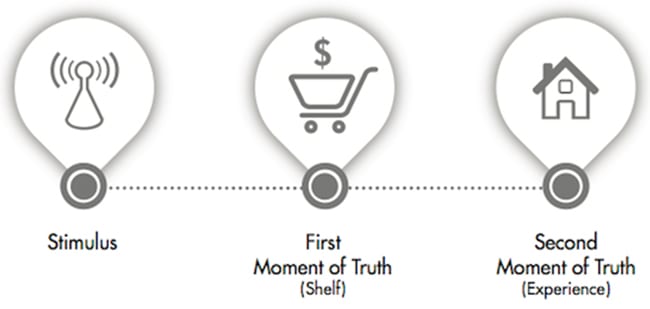Retailers with an excellent reputation in customer experience all share one thing: outstanding product returns management. The product returns process is a moment of truth in the relationship between your customers and your brand. Which is why it’s so important to optimise this step if you want to improve your customer experience. A poor returns...
Retailers with an excellent reputation in customer experience all share one thing: outstanding product returns management.
The product returns process is a moment of truth in the relationship between your customers and your brand.
Which is why it’s so important to optimise this step if you want to improve your customer experience. A poor returns service can have a negative impact on your customer’s overall experience.
You therefore need to measure your customers’ satisfaction with this moment of truth. If you’re reading this article, you probably don’t need convincing. So, how should you go about this? By sending a post-product return satisfaction survey. We’ve included a few examples of key questions to help you build your survey. But first, here’s a quick reminder of why the product return stage is such a decisive step.
Product Return is a Moment of Truth in your Customer Journey
The customer journey is part of the customer’s relationship with your brand, made up of a series of stages. These vary from one brand or sector to another. For example, the first step in retail is the product search. The customer goes to your website or shop, looks at your products (via your online catalogue or in store), adds products to their basket and proceeds to checkout. If the purchase is made online, there is another step: delivery.
Discovery, purchase, delivery… These are all key steps on the customer journey. They are “moments of truth“, that reveal the truth about the customer’s relationship with your brand and which greatly influence their overall opinion.

There’s a but, though. Brands often neglect another important step and moment of truth: product returns. A lot of retailers focus their efforts on the pre-sales steps. This is a mistake. Poor return product management can cause serious harm to the customer relationship.
Returns are not enjoyable for the customer or the brand. They are costly for retailers, especially in ecommerce, where the return rate is estimated at 25% according to a Paazl study (vs. 8% in brick and mortar).
You need to show the same quality of service and that you care about your customers. If you go about it right, you can even turn this irritant into a moment of satisfaction or enchantment! A failed purchase can be a positive experience if the return process is quick and easy.
Now, let’s take a look at some examples of questions you can add to your survey. The objective is threefold:
- Measure customer satisfaction at a key stage.
- Adjust your returns policy to better meet customer expectations and demands.
- Understand why customers return a product, so as to identify areas for improvement to reduce your overall return rate.
8 Sample Questions for your Post-Return Satisfaction Surveys
Below are some key questions to ask your customers when they return a product, relating to:
- Customer satisfaction with the returns process.
- Customer satisfaction with your product returns policy.
- The reasons for the product return.
Question 1 – The Net Promoter Score
Regular blog readers and MyFeelBack users will already know about this indicator. The Net Promoter Score is a satisfaction indicator that consists in measuring your customers’ likelihood to recommend your brand to others. The NPS question can be phrased as follows:
“How likely are you to recommend [brand name] to others?”
The customer gives an answer between 0 and 10. The NPS allows to identify:
- Your promoters: those who give a score of 9 or 10.
- Your detractors: those who answer between 0 and 6.
- Your “neutral” or “passive” customers: those who answer 7 or 8.

To find out more about this key satisfaction indicator and how it works, read our complete NPS guide
This question and indicator will enable you to:
- Calculate your product return rate by customer category (promoters/detractors/neutrals).
- Measure the impact of “product returns” on your customer satisfaction.
- Trigger specific actions based on the customer score. For example, a call-back or reassurance email for detractors, a thank you message for promoters, etc.
Question 2 – What are the main reasons for your return request?
This questions helps understand the main reasons a product is returned. There can be lots of different reasons. Some are out of your control, and others are in part due to your brand.
Here are a few examples of reasons (and therefore possible answers for respondents):
- The item doesn’t meet the customer’s expectations.
- Incomplete product or defective item.
- Wrong size.
- The customer changed their mind.
- Other.
Question 3 – Was the returns process easy to find on our website?
This question seeks to measure the seamlessness of your customer experience. Customers appreciate easy-to-access information and services.
For this question, as for the three others, we recommend using a scale of 1 to 4.
You can group this question and the three others in a matrix to make the survey lighter and enable respondents to answer more quickly.

Question 4 – What do you think about our returns policy?
This question helps you find out what your customers think about your returns policy. Do they think it’s fair? Generous? Not generous enough?
Look at these answers carefully because a customer’s perception of your returns policy directly impacts conversion.
A lot of customers won’t order anything if they are not satisfied with the returns policy.
Question 5 – How would you assess the progress of your return request?
This is important to most customers. They want to be able to check the status of their return / exchange / refund request on a daily basis.
It is another important aspect when qualifying the overall product return step.
Question 6 – How would you rate our returns processing time?
An abnormally long processing time for returns can have serious consequences customers satisfaction. This question, like the last, aims to measure customer satisfaction with the returns process.
Question 7 – The Customer Effort Score
You can also use the “CES” or “Customer Effort Score” in your survey. As its name implies, CES is an indicator that measures the effort exerted by your customers to complete a specific task. You could ask the following question:
“How easy was it for you return your product?”
CES is normally measured on a scale of 0 to 5. The answers to this question will enable you to measure the seamlessness of the “product return” stage on your customer journey.

Question 8 – Did you encounter any particular difficulties when preparing and returning the package?
There are two possible answers to this question: Yes or No. If the answer is Yes, you can go ask customers to expand on this with a dynamic sub-question (this feature is available with MyFeelBack).
Here is an example of a sub-question: “Can you tell us more about the problem?”.
Some examples of answers:
- The packaging,
- Printing the return label,
- Taking to a drop-off point,
- Tracking my request,
- Others (with an empty field).
You could end the survey with an empty text box for suggestions and comments.
You now have several precise examples of questions to ask your customers when they return a product. We hope that this article will help you build your survey and think about how you manage product returns. Over to you!








